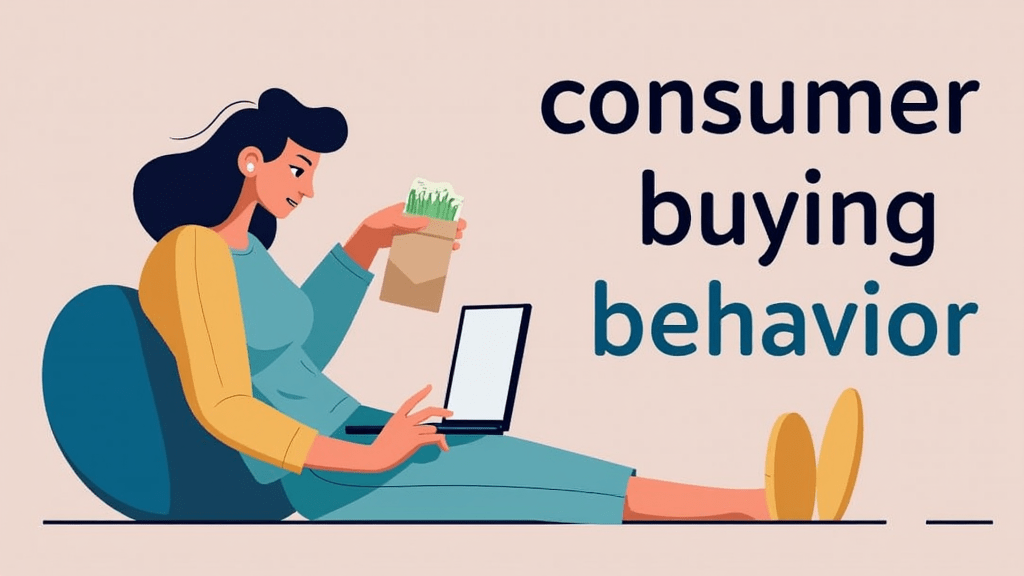Conversion Rate Optimization (CRO) is the process of increasing the percentage of website visitors who complete a desired action—whether that’s purchasing a product, filling out a form, or signing up for a newsletter. Essentially, CRO is about fine-tuning various elements of your website to encourage more visitors to take these actions.
For small business owners and entrepreneurs, driving traffic to your website is only half the battle. The real challenge lies in converting those visitors into paying customers. This is where Conversion Rate Optimization (CRO) becomes an essential strategy. CRO helps transform the passive browsers on your website into active buyers, leads, or subscribers, ultimately driving your business’s revenue and growth. But where do you start? This post will break down the concept of CRO, why it matters, and offer practical tactics to help you increase conversions on a budget.
What is Conversion Rate Optimization (CRO)?
Here’s a simple example: Let’s say your website receives 1,000 visitors per month, and 20 of those visitors make a purchase. This gives you a conversion rate of 2%. If you can make some changes to your website that convince 10 more visitors to buy, you’ve boosted your conversion rate to 3% without increasing your traffic. CRO focuses on maximizing the impact of your existing traffic rather than spending additional resources on bringing in new visitors.
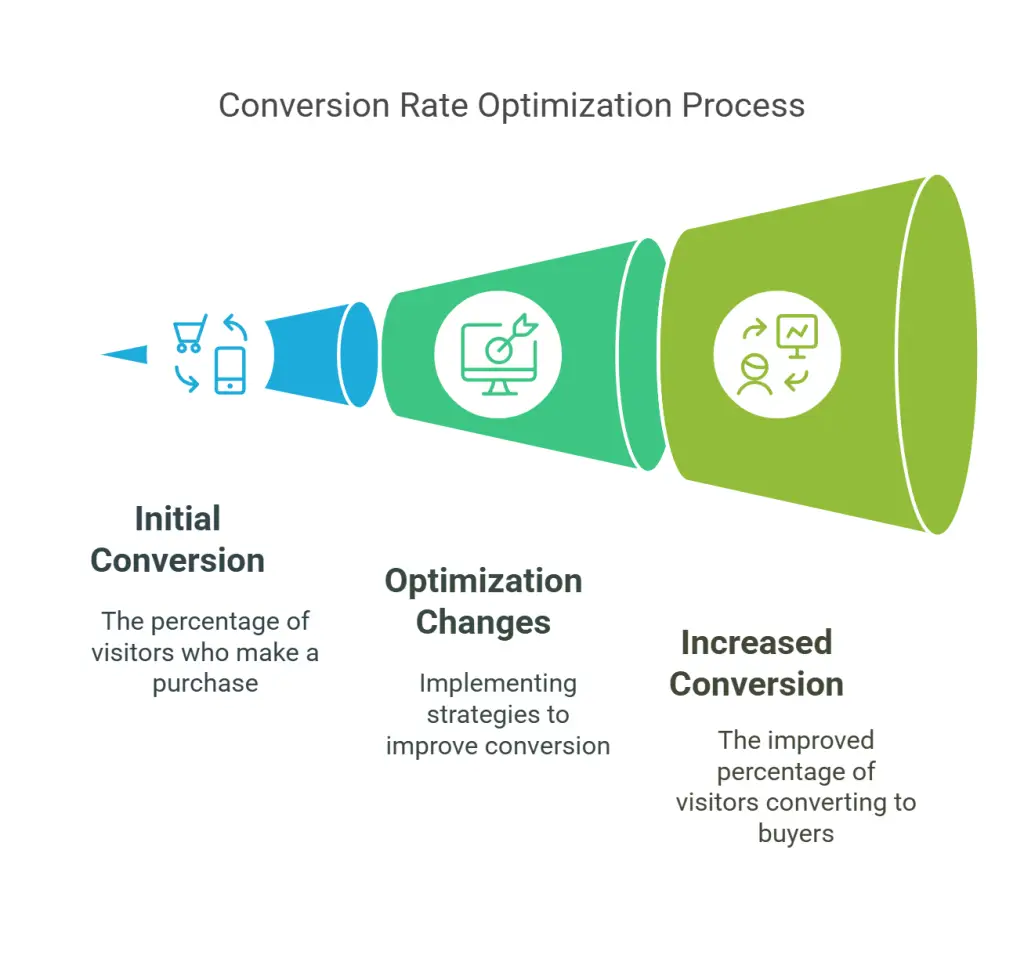
Why is CRO Important?
For entrepreneurs and small businesses, CRO can have a massive impact on growth, especially when working with limited budgets. Increasing your conversion rate can mean more sales, more leads, and ultimately more revenue without needing to invest heavily in new marketing campaigns. A well-optimized website creates a better user experience, builds trust with potential customers, and reduces the friction that might stop someone from converting.
By understanding and applying CRO, you can leverage the traffic you’re already generating and turn it into tangible business results. This makes CRO one of the most cost-effective strategies for small businesses looking to grow without blowing their marketing budget.
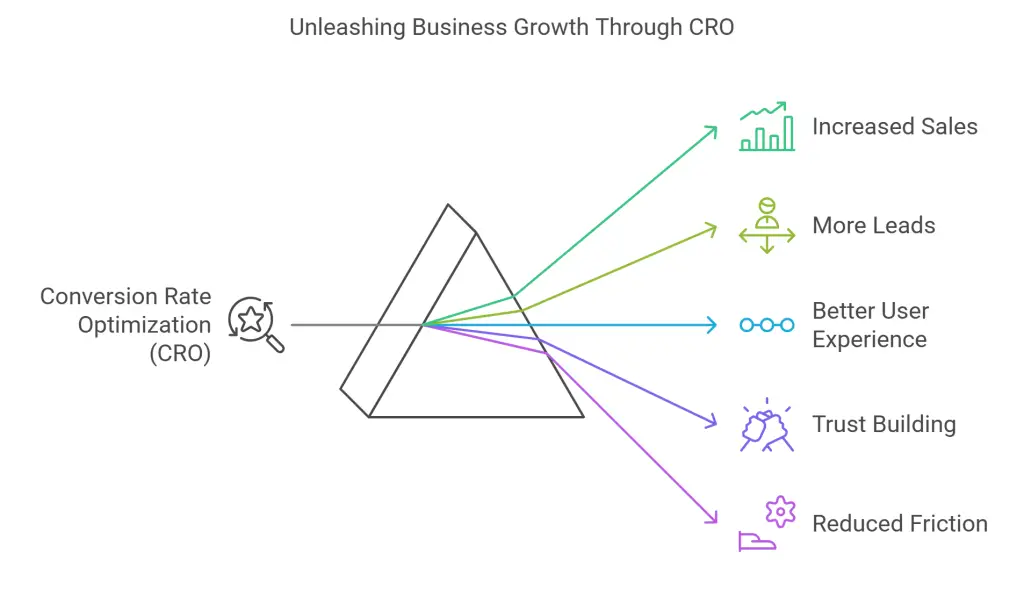
Why Does Conversion Rate Optimization Matter for Small Businesses?
Small businesses often face significant challenges when it comes to competing with larger, more established companies. While big brands can afford massive ad campaigns and complex marketing strategies, small business owners must be smart with their resources. This is where CRO becomes a game-changer.
Increased Sales
At its core, CRO is about increasing sales. By identifying what works and what doesn’t on your website, you can streamline the buyer’s journey, making it easier for visitors to convert. Small tweaks—like improving your call-to-action buttons, simplifying your checkout process, or enhancing product descriptions—can have a significant impact on your bottom line.
Better Customer Engagement
CRO isn’t just about sales; it’s also about improving the overall user experience (UX). When your website is optimized for conversions, visitors are more likely to engage with your content, stay longer, and return in the future. A site that’s easy to navigate and provides a seamless experience leaves a lasting impression on visitors, which can turn one-time shoppers into loyal customers.
Maximized Marketing ROI
For small businesses, every marketing dollar counts. CRO helps you get the most out of your marketing budget by ensuring that the traffic you generate has the best chance of converting. Instead of constantly spending money to bring in more visitors, CRO allows you to extract more value from your existing traffic, increasing your return on investment (ROI).
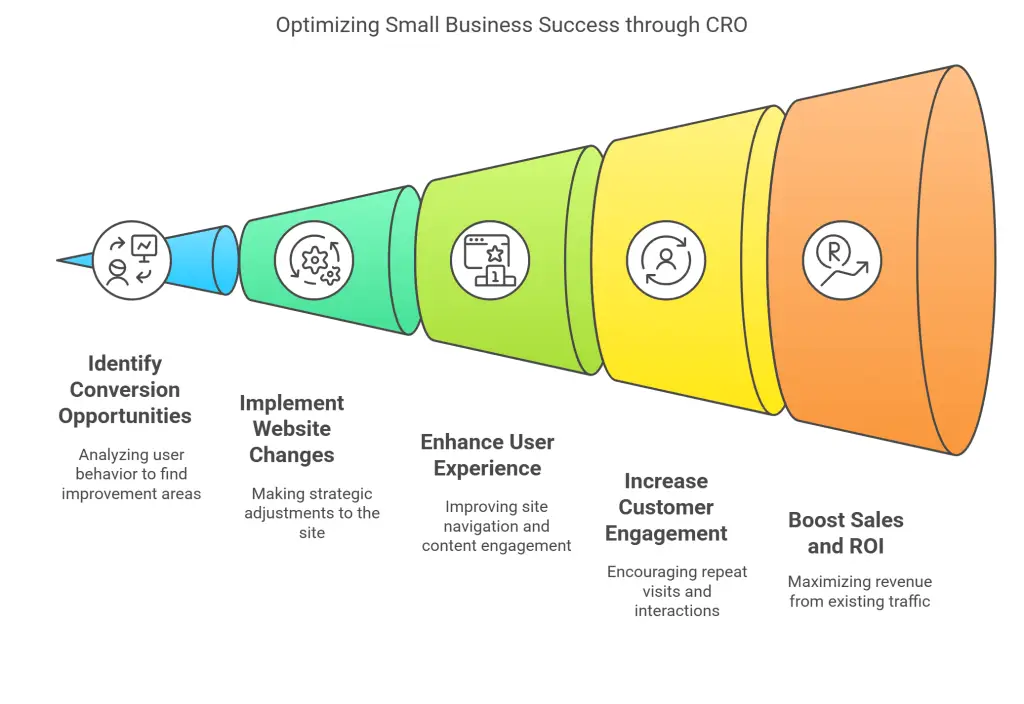
Where to Start with Conversion Rate Optimization?
If you’re new to Conversion Rate Optimization, it can feel overwhelming to know where to begin. However, focusing on key areas of your website can yield quick wins and help you build momentum.
1. Landing Pages
Your landing pages are often the first point of contact for visitors, so optimizing them for conversions is crucial. A well-designed landing page should have a clear and compelling value proposition, a strong call-to-action (CTA), and minimal distractions. It should also be tailored to the specific audience and offer they were promised in the ad or search result that brought them there.
For example, if you’re running a Facebook ad for a free eBook, your landing page should highlight the benefits of the eBook, have an easy-to-fill form for downloading it, and prominently display the download button. Ensure that the landing page aligns with the ad’s messaging and design to create a cohesive experience.
2. Checkout Process
The checkout process is another critical area to optimize, especially for eCommerce businesses. A lengthy or complicated checkout can lead to cart abandonment, which directly impacts your conversion rate. Simplifying the checkout process by reducing the number of steps, offering guest checkout options, and ensuring secure payment methods can help keep customers engaged through to completion.
Think about it from a customer’s perspective. Would you want to go through five different pages just to buy a $10 item? Streamlining this process reduces friction and makes it easier for visitors to become buyers.
3. Calls to Action (CTAs)
Your call to action is the single most important element on your website for driving conversions. Whether it’s a button to “Buy Now,” “Sign Up,” or “Get a Free Quote,” your CTA should be clear, direct, and enticing. Consider the language you use, the placement of the CTA on the page, and its design. Test different colors, sizes, and wording to see what resonates best with your audience.
4. Website Speed and Mobile Responsiveness
Slow-loading pages are conversion killers. Research shows that even a one-second delay in page load time can result in a 7% reduction in conversions. Make sure your site is optimized for speed by compressing images, reducing redirects, and leveraging browser caching.
Additionally, more than half of all web traffic comes from mobile devices, so it’s essential that your site is mobile-responsive. Ensure your site adapts to different screen sizes and offers a smooth experience across all devices. A mobile-optimized site can significantly improve conversion rates by making it easier for users to navigate and complete actions on their phones or tablets.
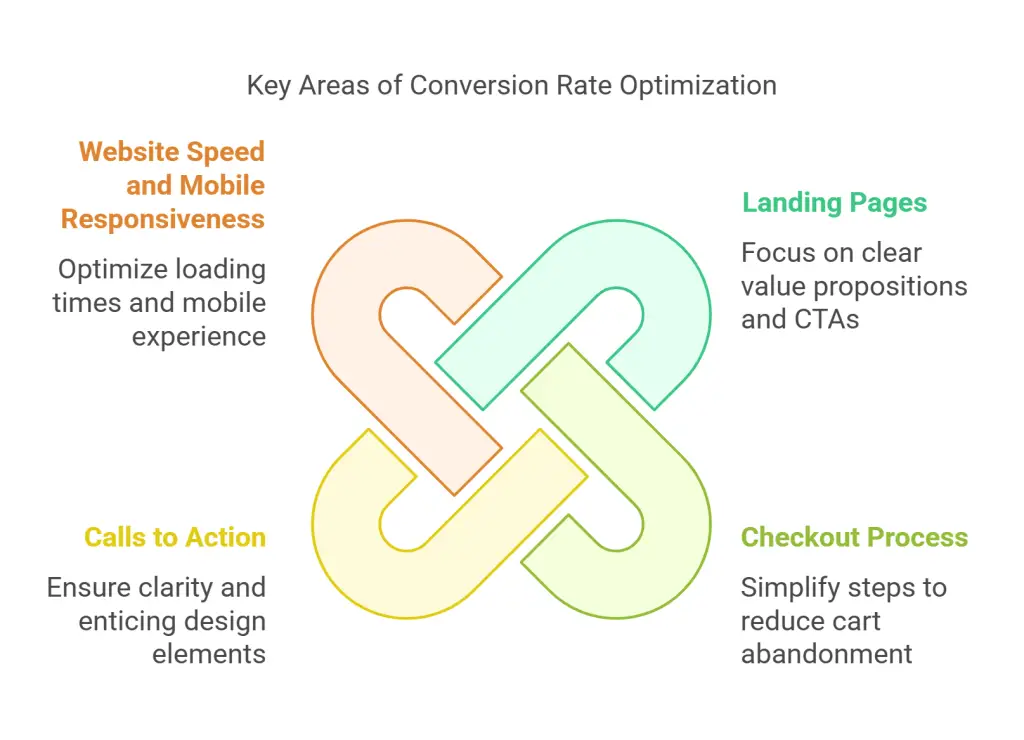
When to Implement CRO Strategies?
Timing is everything when it comes to CRO. You don’t want to overhaul your website based on assumptions; instead, CRO should be data-driven and strategically implemented.
1. After Gathering Data
Before making any changes, it’s essential to gather data about how users are currently interacting with your website. Tools like Google Analytics, Hotjar, and Crazy Egg can help you track user behavior, identify pain points, and understand what’s working well. Look at metrics like bounce rate, exit pages, time on site, and conversion funnels to identify areas that need improvement.
2. During Low-Traffic Periods
If you’re considering a significant website redesign or testing new CRO tactics, aim to implement these changes during periods of lower traffic. This way, any potential disruptions won’t impact as many visitors, and you’ll have the time to properly test and refine your strategies without feeling rushed.
3. When Running A/B Tests
A/B testing (or split testing) is a cornerstone of CRO. It involves creating two versions of a webpage or element (like a CTA) and testing them against each other to see which one performs better. Implement A/B tests when you’re looking to validate a specific hypothesis, such as whether a red button will convert better than a blue one.
By testing one change at a time, you can isolate the factors that are making the biggest impact and make data-driven decisions to improve conversions.
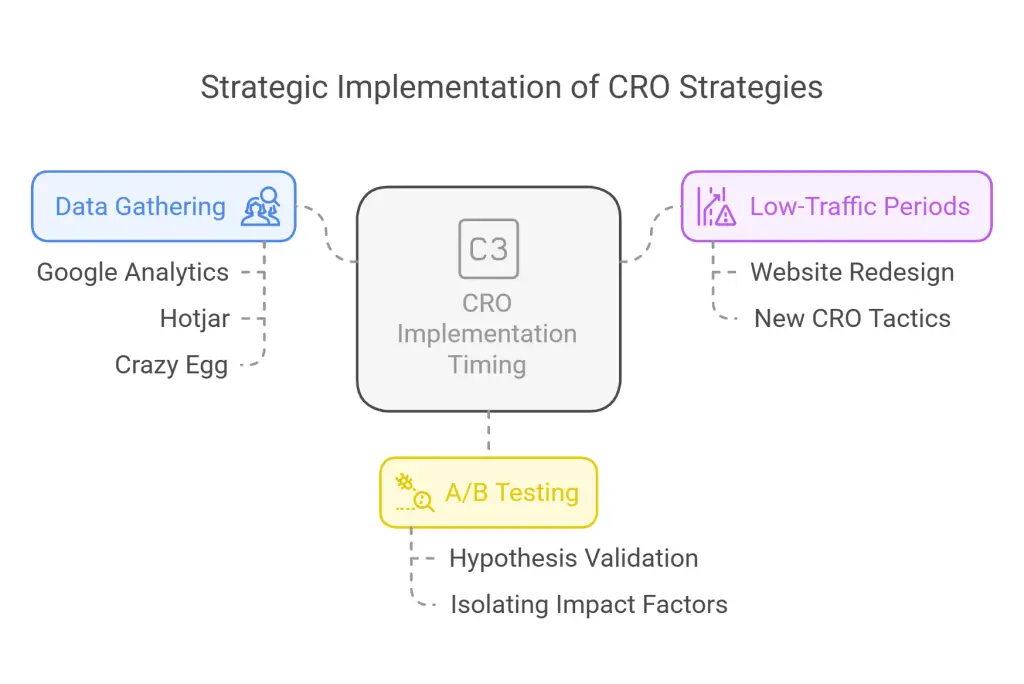
Practical CRO Techniques for Entrepreneurs
CRO doesn’t have to be expensive or time-consuming. Here are some simple, cost-effective strategies that entrepreneurs can implement to boost conversions.
1. Improve Your Value Proposition
Your value proposition is the core of what you’re offering to customers. It should clearly communicate the benefits of your product or service and why it’s better than what the competition offers. Revisit your value proposition and make sure it’s compelling and easy to understand. It should be one of the first things visitors see when they land on your site.
2. Use Trust Signals
Building trust is crucial for conversions. Add trust signals like customer reviews, testimonials, security badges, and money-back guarantees to your website. These elements reassure visitors that your business is credible and that they can trust you with their personal information or payment details.
3. Create Urgency
Urgency can be a powerful motivator for conversions. Techniques like limited-time offers, countdown timers, and scarcity indicators (e.g., “Only 3 items left in stock!”) can encourage visitors to take action more quickly. Just be careful not to overdo it, as false urgency can erode trust.
4. Optimize Forms
If lead generation is your goal, optimizing your forms is critical. Long, complicated forms can deter visitors from completing them. Try reducing the number of fields to only what’s necessary, and make sure your forms are easy to fill out, even on mobile devices. Consider using autofill options or progress indicators to make the process smoother for users.
5. Personalize the Experience
Personalization can help create a more engaging experience for your visitors. Use tools like dynamic content to show personalized recommendations, offers, or messages based on a user’s behavior or demographics. For example, if a visitor is returning to your site, you could greet them with a personalized message like, “Welcome back! We’ve saved your cart for you.”
6. Add Live Chat
Live chat is a great way to engage with visitors in real-time and answer any questions they might have before converting. Whether you use a live agent or a chatbot, offering immediate support can help reduce hesitation and encourage visitors to complete their purchase or sign up.
7. Test and Iterate
CRO is an ongoing process. What works today might not work tomorrow, so it’s essential to continually test and iterate on your strategies. Use A/B testing, user feedback, and data analytics to monitor the performance of your CRO efforts and make adjustments as needed.
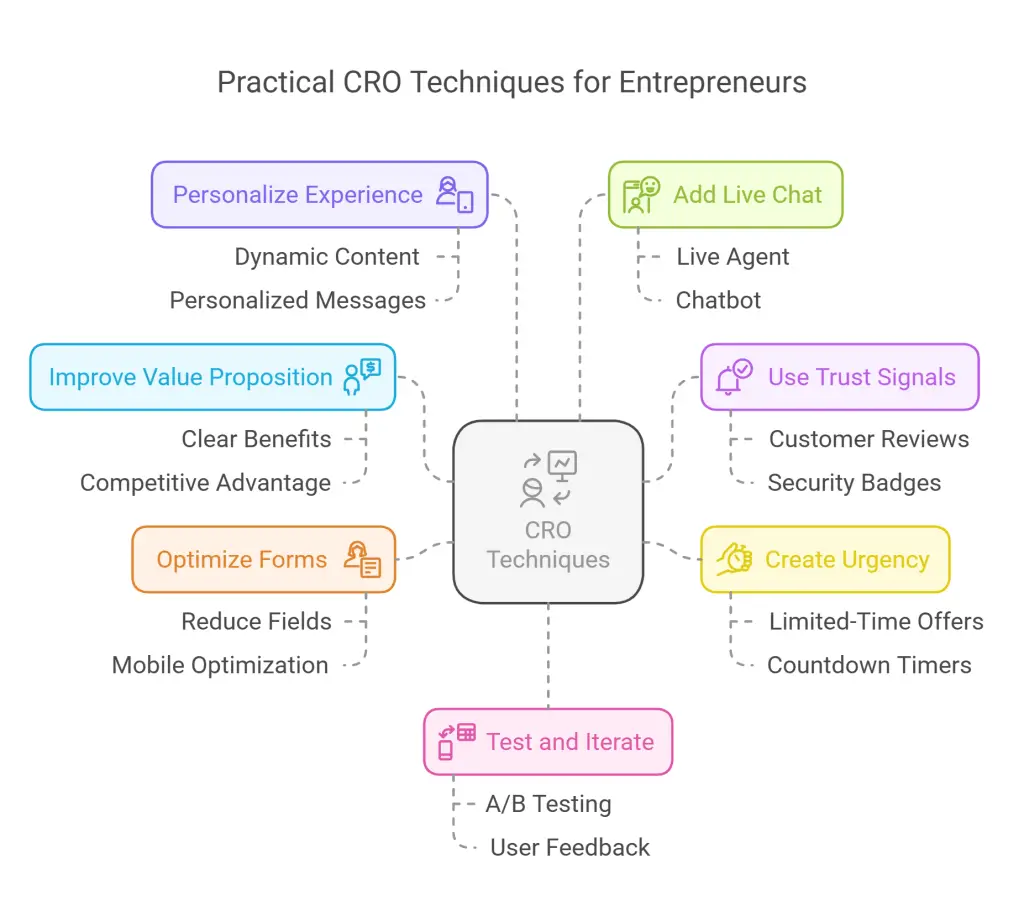
Case Study: How John, the owner of “Mitchell Outdoor Gear” Boosted His Conversion Rates by 45%
Background:
John Mitchell, the owner of “Mitchell Outdoor Gear,” a small e-commerce business specializing in outdoor equipment, faced a common challenge: despite a steady flow of website traffic, his conversion rates were stagnant at around 1.8%. With a limited budget for paid advertising, John realized that optimizing his existing traffic was the most cost-effective way to grow his revenue.

The Challenge:
John’s website had a high bounce rate on key product pages, and many visitors abandoned their carts before completing purchases. Despite investing in SEO and social media marketing, the lack of conversions was holding back business growth. John needed a strategy that would help turn visitors into customers without overhauling his entire website.
The Approach:
John decided to focus on Conversion Rate Optimization (CRO) after reading about its potential for small businesses. He followed a structured approach:
- Data Analysis:
Using Google Analytics and heatmaps, John identified where users were dropping off. The data revealed that product pages were cluttered, the call-to-action (CTA) buttons were not prominent, and the checkout process was too complex. - A/B Testing:
John ran A/B tests to compare different versions of product pages. He tested various elements like:- Simplified product descriptions
- High-quality images with zoom functionality
- More prominent, contrasting CTA buttons
- Streamlining the Checkout Process:
The original checkout had multiple steps that frustrated users. John reduced it to a two-step process, removed unnecessary form fields, and added a guest checkout option. - Trust Signals:
To build customer trust, he added customer testimonials, secure payment icons, and a clear return policy on product pages.
The Results:
After implementing these changes over three months, John saw remarkable improvements:
- Conversion Rate: Increased from 1.8% to 2.6%, a 45% uplift.
- Bounce Rate: Decreased by 20% on key landing pages.
- Average Order Value: Increased by 15% due to effective cross-selling strategies implemented on the checkout page.
Key Takeaways:
Start Small: John focused on key product pages rather than attempting a full website redesign.
- Data-Driven Decisions: CRO efforts were guided by data, not assumptions.
- Continuous Testing: A/B testing helped identify what resonated best with his audience.
John’s experience highlights that even small, data-driven changes can lead to significant improvements in conversion rates, proving that CRO is not just for big businesses with large budgets.
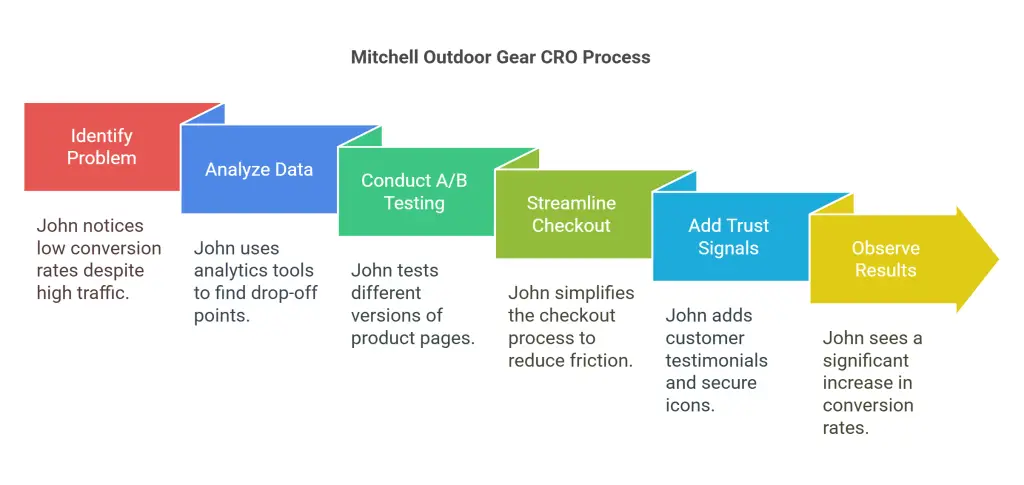
Conclusion
Conversion Rate Optimization is one of the most effective and budget-friendly strategies for small businesses and entrepreneurs. By focusing on turning more of your existing traffic into customers, you can increase revenue without having to continuously pour money into new marketing campaigns. The key to successful CRO lies in understanding your audience, analyzing data, and making informed adjustments to your website that reduce friction and enhance the user experience.
Whether you’re just starting with Conversion Rate Optimization or looking to refine your current strategies, the tactics outlined in this post provide a solid foundation for improving conversions. By optimizing critical areas like landing pages, checkout processes, and CTAs, and implementing practical techniques like trust signals and personalization, you can maximize the value of your website traffic and drive your business forward.
Further reading
Shopify. “Conversion Rate Optimization: The Complete Guide.” Last accessed February 4, 2025. https://www.shopify.com/au/blog/120261189-conversion-rate-optimization.
YouTube. “Conversion Rate Optimization Explained.” Last accessed February 4, 2025. https://www.youtube.com/watch?v=Ymv5cse3vJc.
Wikipedia. “Conversion Rate Optimization.” Last accessed February 4, 2025. https://en.wikipedia.org/wiki/Conversion_rate_optimization.
Audible. The CRO Podcast: Conversion Rate Optimization. Last accessed February 4, 2025. https://www.audible.com.au/podcast/The-CRO-Podcast-Conversion-Rate-Optimization/B09PGKGMW3?source_code=ASSGB149080119000H&share_location=pdp.
Ryte. “Conversion Optimization.” Last accessed February 4, 2025. https://en.ryte.com/wiki/Conversion_Optimization/.
Moz. “Conversion Rate Optimization (CRO).” Last accessed February 4, 2025. https://moz.com/learn/seo/conversion-rate-optimization.



